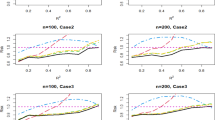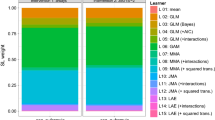Abstract
The estimation of treatment effects on the response variable is often a primary goal in empirical investigations in disciplines such as medicine, economics and marketing. Typically, the investigator would select one model from a multitude of models and estimate the treatment effects based on this single winning model. In this paper, we consider an alternative model averaging approach, where estimates of treatment effects are obtained from not one single model but a weighted ensemble of models. We develop a weight choice method based on a minimisation of the approximate risk under squared error loss of the model average estimator of the conditional treatment effects. We prove that the model average estimator resulting from this criterion has an optimal asymptotic property. The results of a simulation study show that the proposed approach is superior to various existing model selection and averaging methods in a large region of the parameter space in finite samples. The proposed method is applied to a data set on HIV treatment.





Similar content being viewed by others
Data availability statement
The data that support the findings of this study are available from the corresponding author upon reasonable request.
References
Abadie, A., Imbens, G. W. (2006). Large sample properties of matching estimators for average treatment effects. Econometrica, 74(1), 235–267.
Abadie, A., Imbens, G. W. (2011). Bias-corrected matching estimators for average treatment effects. Journal of Business and Economic Statistics, 29(1), 1–11.
Ashenfelter, O. (1978). Estimating the effect of training programs on earnings. The Review of Economics and Statistics, 60(1), 47–57.
Ashenfelter, O., Card, D. (1984). Using the longitudinal structure of earnings to estimate the effect of training programs. Review of Economics and Statistics, 67(4), 648–660.
Belloni, A., Chernozhukov, V., Fernández-Val, I., Hansen, C. (2017). Program evaluation and causal inference with high-dimensional data. Econometrica, 85(1), 233–298.
Belloni, A., Hansen, C. (2014). Inference on treatment effects after selection amongst high-dimensional controls. The Review of Economic Studies, 81(2), 608–650.
Buckland, S. T. (1997). Model selection: An integral part of inference. Biometrics, 53(2), 603–618.
Cattaneo, M. (2010). Efficient semiparametric estimation of multi-valued treatment effects under ignorability. Journal of Econometrics, 155(2), 138–154.
Feng, P., Zhou, X., Zou, Q., Fan, M., Li, X. (2012). Generalized propensity score for estimating the average treatment effect of multiple treatments. Statistics in Medicine, 31(7), 681–697.
Hansen, B. E. (2007). Least squares model averaging. Econometrica, 75(4), 1175–1189.
Hansen, B. E., Racine, J. S. (2012). Jackknife model averaging. Journal of Econometrics, 167(1), 38–46.
Hjort, N. L., Claeskens, G. (2003). Frequentist model average estimators. Journal of the American Statistical Association, 98(1), 879–899.
Hoeting, J. A., Madigan, D., Raftery, A. E., Volinsky, C. T. (1999). Bayesian model averaging: A tutorial. Statistical Science, 14(4), 382–417.
Holland, P. W. (1986). Statistics and causal inference. Journal of the American statistical Association, 81(396), 945–960.
Imbens, G. W., Wooldridge, J. M. (2009). Recent developments in the econometrics of program evaluation. Journal of Economic Literature, 47(1), 5–86.
Kitagawa, T., Muris, C. (2016). Model averaging in semiparametric estimation of treatment effects. Journal of Econometrics, 105(4), 358–368.
Kuersteiner, G., Okui, R. (2010). Constructing optimal instruments by first-stage prediction averaging. Econometrica, 78(2), 697–718.
LaLonde, R. J. (1986). Evaluating the econometric evaluations of training programs with experimental data. The American Economic Review, 76(4), 604–620.
Lee, S., Okui, R., Whang, Y. J. (2017). Doubly robust uniform confidence band for the conditional average treatment effect function. Journal of Applied Econometrics, 32(7), 1207–1225.
Lee, S., Shin, Y. (2021). Complete subset averaging with many instruments. The Econometrics Journal, 24(2), 290–314.
Li, K.-C. (1987). Asymptotic optimality for \({C}_p\), \({C}_l\), cross-validation and generalized cross-validation: Discrete index set. Annals of Statistics, 15(3), 958–975.
Liang, H., Zou, G., Wan, A. T., Zhang, X. (2011). Optimal weight choice for frequentist model average estimators. Journal of the American Statistical Association, 106(495), 1053–1066.
Linden, A., Uysal, S., Ryan, A., Adams, J. (2016). Estimating causal effects for multivalued treatments: A comparison of approaches. Statistics in Medicine, 35(4), 534–552.
Liu, C.-A. (2015). Distribution theory of the least squares averaging estimator. Journal of Econometrics, 186(1), 142–159.
Lv, J., Liu, J. S. (2014). Model selection principles in misspecified models. Journal of the Royal Statistical Society: Series B (Statistical Methodology), 76(1), 141–167.
MacArthur, R. D., Novak, R. M., Peng, G., Chen, L., Xiang, Y., Hullsiek, K. H. (2006). A comparison of three highly active antiretroviral treatment strategies consisting of non-nucleoside reverse transcriptase inhibitors, protease inhibitors, or both in the presence of nucleoside reverse transcriptase inhibitors as initial therapy (CPCRA 058 FIRST Study): A long-term randomised trial. Lancet, 368(9553), 2125–2135.
Newey, W. K. (1997). Convergence rates and asymptotic normality for series estimators. Journal of Econometrics, 79(1), 147–168.
Rolling, C. A., Yang, Y. (2014). Model selection for estimating treatment effects. Journal of the Royal Statistical Society (Series B), 76(4), 749–769.
Rolling, C. A., Yang, Y., Velez, D. (2019). Combining estimates of conditional treatment effects. Econometric Theory, 35(6), 1089–1110.
Seng, L., Li, J. (2022). Structural equation model averaging: Methodology and application. Journal of Business and Economic Statistics, 40(2), 815–828.
Shao, J. (1997). An asymptotic theory for linear model selection. Statistica Sinica, 7(2), 221–242.
Shibata, R. (1980). Asymptotically efficient selection of the order of the model for estimating parameters of a linear process. Annals of Statistics, 8(1), 147–164.
Wan, A. T., Zhang, X., Zou, G. (2010). Least squares model averaging by Mallows criterion. Journal of Econometrics, 156(2), 277–283.
Yang, Y. (2001). Adaptive regression by mixing. Journal of the American Statistical Association, 96(454), 574–588.
Yuan, Z., Yang, Y. (2005). Combining linear regression models: When and how? Journal of the American Statistical Association, 100(472), 1202–1214.
Zhang, X. (2021). A new study on asymptotic optimality of least squares model averaging. Econometric Theory, 37(2), 388–407.
Zhang, X., Liu, C.-A. (2019). Inference after model averaging in linear regression models. Econometric Theory, 35(4), 816–841.
Zhang, X., Zou, G., Carroll, R. J. (2015). Model averaging based on Kullback-Leibler distance. Statistica Sinica, 25(4), 1583–1598.
Zhang, X., Yu, D., Zou, G., Liang, H. (2016). Optimal model averaging estimation for generalized linear models and generalized linear mixed-effects models. Journal of the American Statistical Association, 111(516), 1775–1790.
Zhang, X., Zou, G., Liang, H., Carroll, R. J. (2020). Parsimonious model averaging with a diverging number of parameters. Journal of the American Statistical Association, 115(530), 972–984.
Zhu, R., Wan, A. T., Zhang, X., Zou, G. (2019). A Mallows-type model averaging estimator for the varying-coefficient partially linear model. Journal of the American Statistical Association, 114(526), 882–892.
Acknowledgements
The authors are grateful to Drs. Craig Rolling and Yuhong Yang for providing their codes for the computation of the TECV estimates and to Dr. Yuhong Yang for several helpful discussions. This paper has benefitted from the suggestions and comments of two referees. All remaining errors are ours.
Author information
Authors and Affiliations
Corresponding author
Additional information
Publisher's Note
Springer Nature remains neutral with regard to jurisdictional claims in published maps and institutional affiliations.
Zhao’s work was supported by Capital University of Economics and Business: The Fundamental Research Funds for Beijing Universities (Grant No. XRZ2021042) and Youth Academic Innovation Team Construction project of Capital University of Economics and Business (Grant No. QNTD202303). Zhang’s work was partially supported by the National Natural Science Foundation of China (Grant Nos. (71925007, 72091212 and 12288201) and the CAS Project for Young Scientists in Basic Research (YSBR-008). Zou’s work was partially supported by the National Natural Science Foundation of China (Grant Nos. 11971323, 12031016). Wan’s work was supported by the Hong Kong Research Grants Council (Grant No. 11500419) and the National Natural Science Foundation of China (Grant No. 71973116).
Supplementary Information
Below is the link to the electronic supplementary material.
About this article
Cite this article
Zhao, Z., Zhang, X., Zou, G. et al. Model averaging for estimating treatment effects. Ann Inst Stat Math 76, 73–92 (2024). https://doi.org/10.1007/s10463-023-00876-4
Received:
Revised:
Accepted:
Published:
Issue Date:
DOI: https://doi.org/10.1007/s10463-023-00876-4




